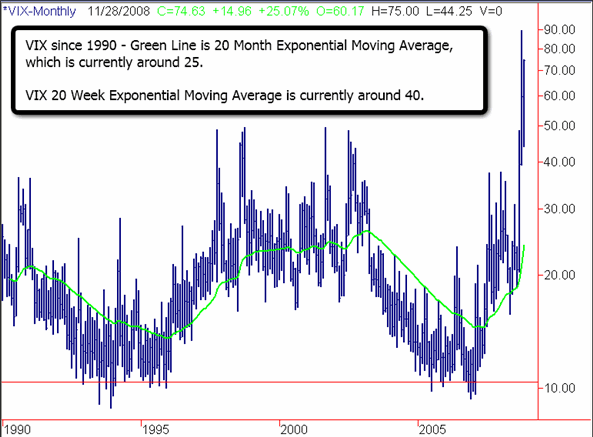| Advanced Trading Strategies For A Volatile Market |
| By Price Headley |
Published
11/20/2008
|
Currency , Futures , Options , Stocks
|
Unrated
|
|
|
|
Advanced Trading Strategies For A Volatile Market
The CBOE Volatility Index (VIX) closed yesterday just below 75 - its "normal" range over the past 20 years or so is around 15 to 35, with most readings in the 20s. Therefore, option implied volatilities are obviously very high right now compared to historical norms. If you come to the conclusion that implied volatilities are going to come down over the next few months and into 2009, how can a trader benefit from this?
VIX Monthly Chart

In order to benefit from a potential implosion in implied volatilities, you may want to diversify your options trading beyond just buying calls and puts. Straight call and put buying is pure time premium/implied volatility buying (for any premium over intrinsic value you are paying).
Here are a few strategies that will allow you to sell implied volatility/option premium, as well as buying it. I go much further in depth into these kinds of Advanced Options Trading strategies in my new BigTrends Coaching Class, and utilize these kinds of strategies in my Trade Advisory Recommendation Service (Advanced Options Strategies, or AOS).
1. Selling Covered Calls/Covered Puts
The simplest of these 3 strategies, this is basically selling an out-of-the-money (OTM) Call against a long stock position you may own. This can be done at the time of the stock purchase (Buy/Write), or against an existing stock position (to protect gains and/or lower cost basis). On the flip side, against a short stock position, you can sell an out-of-the-money "Covered Put". In both of these situations, you end up collecting a "credit" for selling an option, putting yourself "short" time premium and implied volatility. The tradeoff for receiving a credit and lowering your cost basis is that you will limit your potential upside gain to the strike you sold. You will receive the benefit of time premium decay ("Theta") and also potentially gain if the implied volatility on the option you sold comes down.
2. Credit Spreads
Without going into too much depth, a Credit Spread (also known as a "Vertical Bull or Bear Spread"), involves selling an option and buying another option of the same stock in the same expiration month, but of a different strike. You will usually be selling an at-the-money (ATM) or OTM strike and buying a further out strike. So, for example, a Bearish December Credit Spread on XYZ stock (with XYZ shares at 52) might be to sell the December 55 Call while simultaneously buying the December 60 Call. You will receive a credit for selling this 5 point spread - due to the premium on the 55 Call being much higher than the 60 Call. You then theoretically will receive time decay on the position as it approaches Expiration, assuming the stock goes down, stays even, or even rallies a bit - because the 55 Call will lose time premium at a more rapid rate than the 60 Call. You also should benefit if the stock's volatility and/or the option implied volatility drops.
3. Calendar Spreads
The most advanced of the strategies I'm discussing today is Calendar Spreads. This involves trading an option in the Front or Second month for example, and hedging with an option of the same stock, same strike, but in a further out Expiration month. The further out option can be as far out as LEAPs out to the year 2011 currently. A Calendar Spread can in effect be a "Vega" trade, but it can also be done as a "Theta" collection trade. The far out options are basically all Vega, so if you are banking on implied volatilities coming down, you would be looking at Buying the Front or Second month option and Selling the Further out option, such as a LEAP. The reason for this is that the implied volatility portion, or Vega, of the further out option is much higher than the closer expiration. So, even though the Theta, or time decay, of the closer option will decay at a faster rate, a decline in implied volatilities will be more magnified on Vega in the back month options. Another simpler version of a Calendar Spread would be to flip this around by selling a Front Month as it approaches Expiration and buying a Second Month, in order to collect the rapid time decay of the final two weeks heading into Expiration. These kinds of strategies are complex and should be evaluated in an Options Position Analytic software of some sort - in addition you will want to track how the further out implied volatilities move in relation to the front months, as they will not move at the same rate.
Price Headley is the founder and chief analyst of BigTrends.com.
|